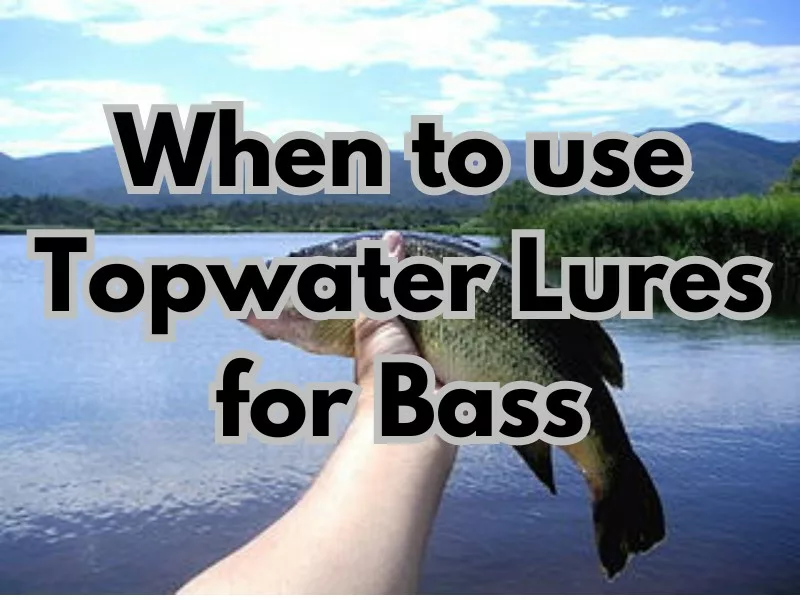Bass fishing is a thrilling experience, and topwater lures can take that excitement to the next level. But when should you use topwater lures? In this guide, we’ll explore the best times and conditions to use these lures, what types of lures work best, and tips for maximizing your chances of success.
Introduction
When it comes to fishing for bass, there are few things more exciting than seeing a big bass explode on a topwater lure. But it can be frustrating when you’re not sure when to use them. Topwater lures can be incredibly effective in certain situations, but they’re not always the best choice. In this guide, we’ll cover everything you need to know about using topwater lures for bass.
Understanding Bass Behavior
To understand when to use topwater lures for bass, it’s important to understand their behavior. Bass are known to be opportunistic feeders, and they often feed on prey that is near the surface of the water. They’ll also come up to investigate anything that looks like it could be food, even if it’s not.
Best Times to Use Topwater Lures
So, when should you use topwater lures for bass? Here are some of the best times:
Early Morning and Late Evening
Early morning and late evening are considered the best times to use topwater lures for bass fishing. During these hours, the water temperature is cooler, calmer and the light is low, making it harder for bass to see prey that’s submerged underwater. Bass are opportunistic hunters and will go after the easiest meal. As a result, they’re more likely to be feeding near the surface where they can more easily see and hear your topwater lure.
Overcast Days
On overcast days, the light is low, making it difficult for bass to see prey that’s submerged underwater. As a result, they’re more likely to be feeding near the surface where they can more easily see and hear your topwater lure.
When the sun is shining bright, bass tend to retreat to deeper waters or areas with cover to avoid the bright light, heat and looking for some cover to hide from prey. However, on overcast days, bass are more likely to be actively feeding because the light is dimmer and the water temperature is cooler.
Additionally, overcast conditions can create a sense of security for the bass. The low light and cloudy skies provide a natural cover, making the bass feel more comfortable and less cautious. They feel like they’re hidden if the sun is not shining on them. This means that they are more likely to strike at a topwater lure that appears to be a vulnerable prey item on the surface of the water.
Overall, the combination of low light, cooler water temperatures, and a sense of security on overcast days makes it an ideal time to use topwater lures for bass fishing.
When the Water is Calm
When the water is calm, it’s easier for bass to see and hear your topwater lure. Calm waters also mean that the surface of the water is undisturbed, making it easier for you to control the movement of your topwater lure. Water is typically more calm during early morning or overcast days. Sometimes a few great top-water conditions will line up together making it a great signal to try some casts with your topwater lures.
When Bass are Active
Bass are most active when the water temperature is between 60 and 75 degrees Fahrenheit. During these times, they’re more likely to be feeding near the surface. They’re likely to be very active and feeding on a nice warm spring day, so almost any lure can work in this situation.
When There’s Vegetation
Bass like to hide in vegetation, and topwater lures can be very effective when fishing in or around vegetation. This tip is to keep your lures safe. Underwater rigs and lures will likely snag on vegetation and you’ll have to cut loose your expensive gear. If the vegetation is dense slowly and naturally troll a topwater lure by some hiding spots and see if you can get any interest from the bass.
Types of Topwater Lures
There are several types of topwater lures that can be effective when fishing for bass. Here are some of the most popular:
Popper
Poppers create a popping sound when you jerk them, which can attract bass to the surface.
Frog
Frog lures mimic the movement of a frog on the surface of the water. They’re very effective when fishing in or around vegetation.
Walk the Dog
Walk the dog lures create a side-to-side movement on the surface of the water, which can be very effective when bass are feeding near the surface.
Buzzbait
Buzzbaits create a buzzing sound when they’re retrieved, which can attract bass to the surface.
Tips for Using Topwater Lures
Vary Your Retrieve Speed
When using topwater lures, it’s important to vary your retrieve speed to mimic the action of a real prey item. You can start with a slow retrieve and gradually increase your speed until you find a speed that works. You can also pause your retrieve occasionally to create a more realistic presentation.
Use the Right Rod and Line
Using the right rod and line can make a big difference when fishing with topwater lures. A medium or medium-heavy power rod with a fast action is ideal for casting and retrieving topwater lures. As for line, use a monofilament or fluorocarbon line in the 8- to 12-pound test range, depending on the size of the lure and the size of the bass you’re targeting.
Choose the Right Lure
Choosing the right topwater lure is essential for success in bass fishing. Different lures work better in different situations, so it’s important to choose the right one for the conditions you’re fishing in. Some popular topwater lures for bass include poppers, buzzbaits, frogs, and walk-the-dog lures.
Watch for Strikes
It’s important to keep a close eye on your lure and be ready for a strike at any moment when using topwater lures. Look for any movement, swirls, or other signs of activity around your lure, as this could indicate a bass is getting ready to strike. Once you see a strike, wait for a second before setting the hook to make sure the bass has the lure in its mouth.
Be Patient
Using topwater lures requires patience and persistence. It may take several casts before you get a strike, so be patient and keep at it. Remember, bass may be watching your lure from a distance, so be sure to give it time to work its magic before reeling it in.
Be Mindful of Your Surroundings
When using topwater lures, it’s important to be mindful of your surroundings. Try to avoid casting your lure into vegetation or other obstacles that could cause it to get stuck or tangled. It’s also important to be aware of any other boats or anglers in the area to avoid any accidents.
By following these tips, you can improve your chances of success when using topwater lures for bass fishing. Remember to vary your retrieve speed, use the right rod and line, choose the right lure, watch for strikes, be patient, and be mindful of your surroundings. With a little practice and patience, you can become a master at using topwater lures for bass fishing.

